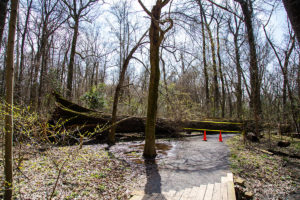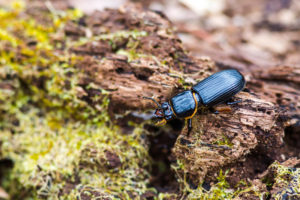If a tree falls in the forest…
 [Originally posted April 24, 2013; updated with new content.]
[Originally posted April 24, 2013; updated with new content.]

Overton Park is full of beautiful old trees. Many specimens in the Old Forest State Natural Area are estimated to be around 200 years old. But it’s not just old trees that are subject to falling during a wind or thunderstorm event–young trees that aren’t structurally sound can fall at any time too. On the exterior of the forest, it’s easier to spot trees that aren’t healthy and take steps to remove them before they become hazardous. But what about in the woods?
Within the Old Forest, occasional tree death is a fact of life. The windstorms last week caused two notable tree falls–one, a beloved old Shumard oak at the entrance to the Old Forest Loop trail, and the other a cherrybark oak that fell near an intersection of trail segments closer to East Parkway Pavilion. The cherrybark hit another large tree on its way down, and that tree in turn toppled over a few days later.

Our general philosophy in the forest is to let trees lie where they fall, much as they would in a forest untouched by human intervention. This doesn’t always look like the most attractive way to manage a forest–large tree limbs just lying around amid all this other growth. But in a forest, a tree’s work is far from done after it’s dead. Here are a few of the reasons why we don’t remove dead trees from the woods:
- Dead trees help create soil. Rotting wood is colonized by fungi and mosses, which break it down into nutrients that enrich the soil. In turn, wildflowers, ferns, and new trees have a welcoming environment to take root, and erosion of the existing soil is reduced.
- They’re an excellent habitat source. Dead trees make a whole menagerie of life possible–from ants to toads to raccoons. Whole life cycles begin when a tree falls: insects move in, then woodpeckers make holes in the trees to pluck out the insects, then smaller birds like wrens and chickadees make their nests in those cavities.
- They provide a natural reservoir. Large trees that fall over create pits where their roots had been and mounds where the trees decay. The pits trap water and leaves, helping reduce water runoff (which has the added benefit of less water collecting on walking trails). Pits and mounds support different kinds of life, which only adds to the richness of biodiversity in the forest.
- And finally…moving huge trees is hard! Imagine how long it would take–and how hard on a worker’s back it would be–to move several tons of tree through the narrow trails of the forest, especially since vehicles can’t be driven into the woods.
Unfortunately, both of last week’s trees fell right across walking trails, so we needed to take some kind of action. So we called our friends at Urban Forestry, who cleared the debris from the Shumard oak from the limestone trail to quickly reopen this path for runners.
Because the base of the tree is 7-8 feet high even when lying on the ground, we decided it would be unsafe to slice a path through it with chainsaws so that people could continue using the usual entrance to the nature trail. Instead, we’re slightly rerouting the entrance to the Old Forest Loop around the base of the tree, which should provide a fascinating up-close look at how its decay will support new life.
The cherrybark oak in the forest interior was cleared from the trail, and because it was smaller in diameter the crew was able to cut some “cookies” (small slices of the trunk) to indicate where pedestrians should go in order to stay on marked trails. As the groundcover in this area re-establishes and makes the path more obvious, we’ll likely remove those cookies.
If you see a tree that looks potentially dangerous (particularly in the more open, landscaped areas of the park), please let us know. The City of Memphis handles tree removal, and we’re happy to communicate with them if you see something that concerns you.


